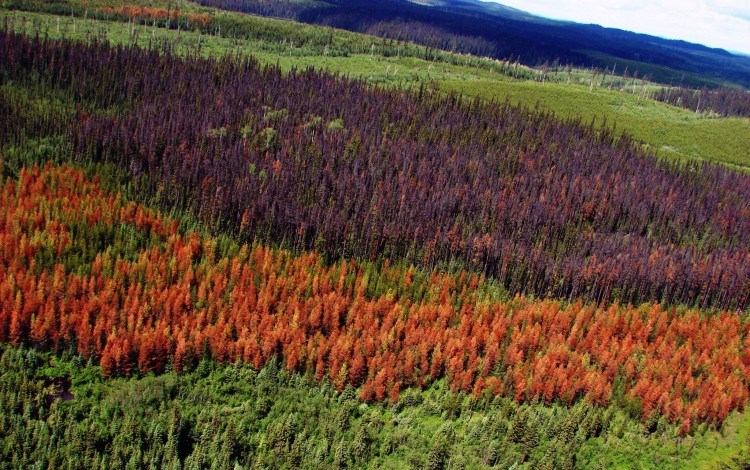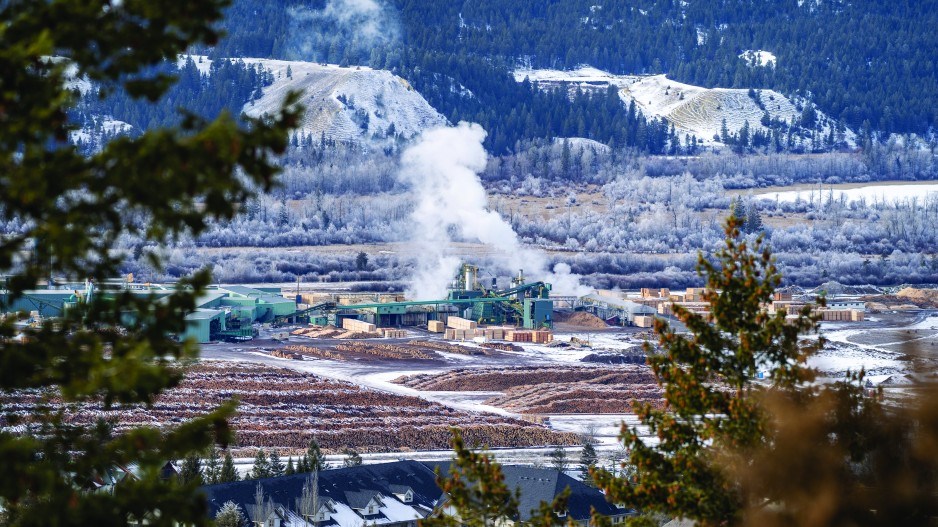The current wave of sawmill closures and curtailments rippling through B.C. had been expected for at least a decade.
But few expected that wave to hit so fast and furious.
In recent weeks, B.C. forestry companies have announced the closure of four sawmills, and several have eliminated, or plan to eliminate, shifts at mills that are still operating.
They include:
•Canfor Corp. (TSX:CFP), permanently shutting down its sawmill in Vavenby;
•Tolko Industries, permanently shutting down its Quest Wood sawmill in Quesnel and eliminating one shift at its mill in Kelowna;
•West Fraser Timber Co. (TSX:WFT), permanently shuttering its Chasm lumber mill near Clinton and 100 Mile House and eliminating the third shift from its 100 Mile House mill;
•Norbord Inc. (TSX,NYSE:OSB), indefinitely curtailing production at its oriented strand board (OSB) mill in 100 Mile House.
Jim Girvan, a forestry consultant who estimated in 2010 that 16 Interior lumber, veneer and plywood mills would shut down in B.C. by 2019 – which is exactly how many did – more recently predicted in May that another 13 mills will have to go.
Since his May prediction, four mill closures have been announced, which mean nine will follow before long if his projections are correct.
And because B.C.’s forestry sector is so highly integrated, the next wave of plant closures could be pulp mills and other processors that use wood waste from nearby sawmills.
“That’s our next concern, is the next shoe has to drop,” said Bob Simpson, former BC NDP forestry critic and current mayor of Quesnel, which will suffer roughly 210 job losses as a result of mill closures.
“As sawmills go down, then all the residual dependent businesses become much more vulnerable.”
In mid-June, Canfor Pulp Products Inc. (TSX:CFX) announced a temporary curtailment at its pulp mill in Taylor, and more recently it announced production curtailments at its Intercontinental and Northwood NBSK pulp mills in Prince George.
B.C.’s Interior forestry sector is being hit the hardest, largely because of the mountain pine beetle epidemic that peaked in 2005, wiping out roughly half of the merchantable timber in the region, according to Natural Resources Canada.
With a population of just 1,800, 100 Mile House is being hit particularly hard with the announced closure of the Norbord OSB mill, West Fraser’s Chasm mill and the elimination of one shift at the West Fraser mill.
Because the West Fraser mill in 100 Mile House is so big, the elimination of one shift is tantamount to the shutdown of a regular-sized sawmill. In total, the direct job losses for 100 Mile House tally more than 400.
“That’s direct jobs,” said 100 Mile House Mayor Mitch Campsall. “Those aren’t indirect, which is the logging industry and what have you. It could be close to 1,000.”
The community recently convened an emergency meeting with provincial officials and industry leaders to try to address anticipated social impacts and retraining.
In towns like 100 Mile House and Quesnel, it’s not just the loss of jobs that hurts. Many of these smaller communities rely heavily on industrial taxes, so when a mill permanently closes, it can blow a significant hole in the community’s tax base.
Quesnel anticipated the current wave of mill closures and began working a few years ago to brace for it by shifting some of the tax burden from industrial to the residential sector, and through economic diversification.
As a former NDP forestry critic, Simpson knew what was coming and has tried to prepare Quesnel for the inevitable. He expressed frustration with some of his mayoral peers for not doing likewise.
“I’m really struggling with mayors who are wringing their hands in public and going, ‘Oh my God, what do we do now?’” Simpson said. “In our case, we started on our transition strategy in 2014. Community plans should already have been in place for that transition.”
By “transition” he means adapting to the reality that B.C.’s forestry sector has entered a long-term contraction that will last decades.
Quesnel still has operating sawmills and two nearby pulp mills. But Simpson expects his community may not have seen the end yet of mill rationalization.
“This has been a long, slow burn, knowing that at some point around 2019, 2020, we were going to have a massive rationalization in the industry,” he said. “And there’s more. We’re not done.”
The current wave of mill rationalization would likely have started earlier, but a strong U.S. economy drove the demand, and prices, for lumber so high that it made it economic to continue processing wood products from a shrinking timber supply, despite rising log costs and American softwood lumber tariffs.
But when U.S. lumber prices began to fall in 2018, companies very quickly began taking mill curtailments, followed by announcements.
Some of B.C.’s biggest forestry companies went from posting record profits in 2018 to posting first-quarter losses in 2019.
While a recovery of lumber prices in the U.S. could postpone more curtailments and mill closures, the long-term prospects are that the B.C. forest sector will inevitably continue to shrink.
Climate change impacts
While scientists cannot directly ascribe extreme weather events or forest fires to climate change, the evidence is compelling that the pine beetle epidemic that ravaged B.C. forests was very likely a result of global warming.
“Climate change has contributed to the unprecedented extent and severity of this outbreak,” Natural Resources Canada scientists, writing about the pine beetle epidemic, concluded in a paper published in Nature in 2008. “The current outbreak in British Columbia, Canada, is an order of magnitude larger in area and severity than all previous recorded outbreaks.”
And things could get even worse for Canadian forests, according to a recent special report by the Council of Canadian Academies, which identifies forestry as one of the top six areas of risk in Canada from the effects of climate change.
“The rate at which forests are anticipated to change is estimated to be beyond the natural capacity for forest species to sufficiently adapt,” the report warns.

Pine beetle infestation provided wood bonanza
For right or wrong, the Gordon Campbell government decided to make lemonade from the lemon that climate change handed B.C.’s forest industry, by increasing the annual allowable cut to let companies salvage what they could from the fresh beetle kill while the wood was still usable.
It provided forestry companies with a decade-long bonanza of timber.
Simpson said he believes it ultimately amplified the crash. Quesnel’s annual allowable cut before the pine beetle epidemic was 2.3 million cubic metres.
“We went up well above four million of actual cut during the height of the salvage operations,” Simpson said.
“West Fraser, as a milling operation, went from a log diet of about 800,000 or 900,000 cubic metres to today, which is 2.2 million cubic metres annually.
“So their log demand for the mills far exceeded even the previous long-term sustainable cut, so that’s what’s creating the double whammy,” Simpson said.
Girvan said he doesn’t fault the Campbell government for bumping up the annual allowable cut in the wake of the pine beetle epidemic.
“It was good for the province; we utilized timber that was otherwise dead,” he said. “The forest was killed. We couldn’t do anything about it so we salvaged and did the best we could.”
Pre-pine beetle, the allowable cut for the Interior was about 50 million cubic metres, Girvan said. It was bumped up to 70 million at the height of the pine beetle bonanza and is now back down to 50 million. Girvan estimates it will shrink to 41 million by 2025.
“Our modelling shows that, within 30 to 40 years, the allowable cuts will all come back up,” Girvan said, “so long as some other catastrophe doesn’t happen.”




